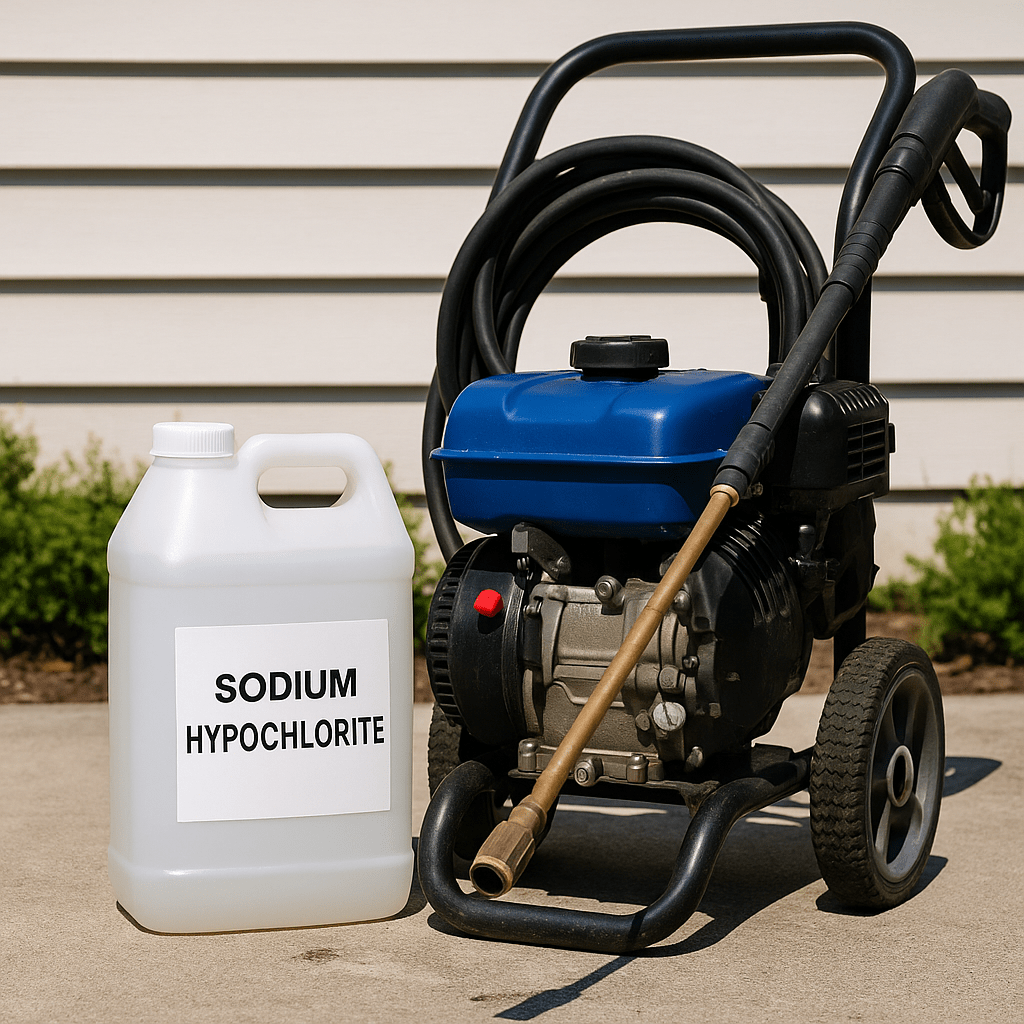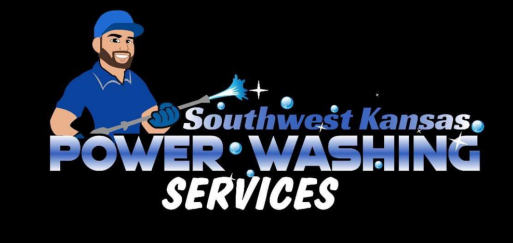What Is SH (Sodium Hypochlorite) in Pressure Washing?

SH stands for Sodium Hypochlorite, the chemical at the heart of professional-grade cleaning results. It’s what pros rely on to break down mold, mildew, algae, and years of grime, the kind of dirt that water and pressure alone can’t touch. So if you've ever wondered how a roof turns from black-streaked to spotless, or how siding goes from green to gleaming in one pass, SH is the answer.
This isn’t just “bleach”, it’s a purpose-driven solution formulated for soft washing and exterior surface restoration. Whether you're a pressure washing business owner, a new technician, or a homeowner doing your research, understanding how SH works will help you use it better, safer, and more effectively.
In this guide, we’ll break down exactly what SH is, how it’s used, when to avoid it, and how to stay safe and more in this guide.
What is SH Bleach?
SH Bleach refers to the same thing as SH in the pressure washing industry which is Sodium Hypochlorite (typically in a higher concentration than household bleach (commonly 10–12.5%)). It's a strong bleach solution commonly used to clean and kill organic growth like mold, mildew, and algae on exterior surfaces. Some people in the industry just call it SH, while others might say SH Bleach—but they’re talking about the same thing. The term “bleach” is often used to make it more understandable for customers, but whether you hear SH or SH Bleach, it’s the same chemical being used in your mix.
Calculating SH Percentage Concentration
When mixing your cleaning solution for pressure or soft washing, it’s important to know what final SH (Sodium Hypochlorite) percentage you’re applying to a surface. This helps ensure your mix is strong enough to clean effectively, but not so strong that it causes damage or wastes product.
Getting your SH concentration right is key to a successful clean. If your mix is off, it can lead to poor results or even damage. Here's why:
Too weak: Won’t kill mold or remove organic growth effectively. Too strong: Could damage surfaces, harm landscaping, or waste product.The Basic Formula of SH
(SH strength %) × (amount of SH used) ÷ total mix volume
Example:
If you're mixing 2 gallons of 12.5% SH with 3 gallons of water:
12.5% × 2 ÷ (2 + 3) = 25 ÷ 5 = 5%
Your final mix has a 5% SH concentration.
Concentration Ratios for Pressure Washing
Roof Cleaning
- Target SH concentration: 3%–6%
- Use a stronger mix to effectively kill mold, algae, and lichen on shingles or tile.
- Always pre-wet and rinse plants thoroughly to avoid damage.
House Washing
- Target SH concentration: 0.5%–1%
- Perfect for vinyl, painted wood, and stucco siding.
- Gentle enough to protect finishes while removing surface-level mildew and dirt.
Concrete Cleaning
- Target SH concentration: 2%–4%
- Effective for treating organic stains, mold, and algae on driveways, patios, and sidewalks.
- Higher concentration may be needed for neglected or heavily stained areas.
Understanding SH: The Chemical Power Behind Soft Washing
The Chemistry of SH (Sodium Hypochlorite)
SH is the active ingredient in industrial-grade bleach, with a chemical formula of NaOCl. It's a strong oxidizing agent that kills and breaks down organic growth like algae, mold, mildew, and bacteria. Compared to household bleach (typically 5-6% strength), SH used in pressure washing is much stronger, usually 10-12.5%.
Common Names for SH (Sodium Hypochlorite) In The Pressure Washing Industry
- SH
- 12.5% bleach
- Pool shock
- Roof mix component
What Does SH (Sodium Hypochlorite) Do in Pressure Washing?
Organic Stain Killer
Sodium Hypochlorite (SH) is widely respected in the pressure washing industry for its ability to eliminate organic growth at the root. Unlike water and pressure alone, which may only remove surface grime temporarily, SH penetrates porous surfaces and chemically breaks down unwanted growth.
- Mildew and mold: These fungi thrive in shaded, damp areas, especially on siding, stucco, and roofs. SH neutralizes spores and removes visible staining.
- Algae and lichen: Common on roofs and concrete, algae create dark streaks, while lichen can cling tightly to surfaces. SH loosens their grip and kills the organism.
- Moss: Found on shaded roofs or pavers, moss retains moisture and can cause damage over time. SH dries it out and kills it at the root.
- Bacteria and organic stains: SH also disinfects surfaces by killing bacteria and breaking down organic matter like bird droppings or leaf stains.
This powerful action helps surfaces stay cleaner, longer, and prevents rapid regrowth.
Surface Restoration
Beyond just killing mold and algae, SH plays a critical role in restoring the original appearance of exterior surfaces. Its bleaching and oxidizing properties help remove years of staining, discoloration, and buildup that make a surface look aged or dirty.
- Asphalt shingle roofs
- Vinyl siding
- Stucco
- Brick and stone
- Concrete driveways and walkways
Used correctly, SH doesn't just clean, it transforms surfaces to look fresh, well-maintained, and property-value friendly.
Sodium Hypochlorite in Soft Washing vs. Pressure Washing
While often lumped together with traditional pressure washing, SH (Sodium Hypochlorite) is primarily used in a method called soft washing. Unlike high-pressure washing, which relies on powerful water force to blast away grime, soft washing uses low pressure and a chemical solution (usually SH mixed with a surfactant) to gently remove organic growth and surface stains. This makes it ideal for delicate surfaces like vinyl siding, asphalt shingles, painted wood, and stucco.
High-pressure washing can damage these materials by stripping paint, dislodging shingles, or forcing water behind siding. SH, on the other hand, penetrates and breaks down contaminants at the root, while the low-pressure rinse washes them away without harm. It’s a safer, more effective solution for surfaces that require a gentle touch.
When Not to Use SH (Sodium Hypochlorite)
While SH is highly effective, it’s not always the right choice. Avoid using SH on surfaces that are sensitive to bleach or chemical reactions. This includes natural wood that hasn't been sealed, oxidized aluminum siding, and certain outdoor fabrics.
Also, SH should never be run through high-pressure pumps or traditional pressure washer systems not rated for chemical use — doing so can corrode internal components and void warranties. SH is designed to work through soft wash systems, downstream injectors, or batch mix setups that are built to handle chemical solutions safely.
SH (Sodium Hypochlorite) Dilution Ratios for Every Surface
How to Mix SH Correctly
SH must be diluted properly to be safe and effective. Overusing it can damage surfaces, kill plants, or corrode equipment.
SH Dilution Chart by Surface Type
| Surface Type | SH % Recommended | Notes |
|---|---|---|
| Asphalt Roof | 3–5% | Add surfactant for cling and dwell time |
| Vinyl Siding | 1–2% | Rinse the glass and plants thoroughly |
| Stucco | 2–3% | Let it dwell longer, rinse gently |
| Concrete Driveway | 3–4% | Use post-treatment if needed |
| Wood Fencing | 1% max | Always rinse thoroughly |
You can use batch mixing (pre-mixed in a tank) or a proportioner to mix SH on the fly. Never guess; always measure.
Safety Protocols When Using SH (Sodium Hypochlorite)
Using Sodium Hypochlorite (SH) in exterior cleaning is incredibly effective, but it comes with risks that demand respect and the right safety protocols. Because SH is a highly reactive chemical, it can cause injury to people, damage to property, and harm to the environment if not handled correctly. Whether you’re a seasoned pro or just starting out, following best practices is critical.
Personal Protection Equipment (PPE)
- Chemical-resistant gloves: nitrile or rubber, not latex or fabric
- Safety goggles or full-face shield
- Respirator with organic vapor/acid gas cartridges in enclosed spaces
- Wear a chemical-resistant apron; avoid cotton clothing
SH Is Corrosive (Here’s How to Handle It)
- Avoid skin and eye contact. Rinse immediately if contact occurs.
- Don’t inhale fumes. Use in well-ventilated areas.
- Wash exposed clothing and equipment after use.
- Store in sealed, labeled containers, out of sunlight and heat.
Protecting Landscaping and Non-Target Areas
- Pre-wet all nearby vegetation before spraying SH.
- Rinse everything after application.
- Cover delicate plants with breathable tarps if needed.
- Use a neutralizer like sodium metabisulfite when necessary.
Equipment Compatibility with SH (Sodium Hypochlorite)
SH is highly corrosive and can ruin standard pressure washing gear. You must use SH-safe equipment to prevent system failures, leaks, and safety hazards.
Use SH-Rated Pumps Only
Use diaphragm or booster pumps labeled SH-compatible or bleach-safe. Avoid piston pumps not rated for SH.
Use Poly Tanks and Hoses
- Use UV-resistant polyethylene tanks
- Use braided PVC or poly-reinforced hoses
- Never use garden hoses or non-rated tubing
Stick to PVC or Stainless Steel Fittings
- Use Schedule 80 PVC or 316-grade stainless steel
- Avoid brass, copper, and aluminum — all will corrode
Flush Equipment After Every Use
- Rinse tanks, pumps, hoses, and wands with clean water
- Let fresh water sit briefly in the pump to neutralize SH
Environmental Considerations
- Avoid overspray into storm drains or sewers
- Do not allow runoff to enter waterways
- Use biodegradable surfactants
- Follow EPA and local disposal regulations
Common Myths About SH (And the Truth)
It’s Just Bleach
False. SH is a higher concentration of bleach used for industrial and commercial cleaning.
More SH = Better Results
Not necessarily. Too much SH can damage surfaces and harm plants.
SH Is Unsafe to Use
Only if misused. With proper PPE and techniques, SH is safe and reliable.
Frequently Asked Questions (FAQs)
Is SH (Sodium Hypochlorite) safe for my roof or siding?
Yes, if properly diluted and applied with soft wash techniques.
Can I use SH (Sodium Hypochlorite) with my pressure washer?
No. Only use with soft wash systems or downstream injectors rated for chemicals.
What surfactants mix with SH?
Use SH-stable products like Elemonator, Southern Drawl, or Snotmenade.
How long should SH dwell before rinsing?
Typically 5–15 minutes. Keep it wet. Do not let it dry on the surface.
Will SH (Sodium Hypochlorite) harm my landscaping or lawn?
Not if plants are pre-wet, covered if needed, and rinsed after application.
What’s the shelf life of SH (Sodium Hypochlorite)?
About 3 months. Store sealed in a cool, shaded area to preserve potency.
How do I dispose of leftover SH (Sodium Hypochlorite)?
Dilute thoroughly with water and dispose according to local regulations.
CONNECT WITH YOUR LOCAL POWER WASHING SPECIALIST TODAY!
